Radio Planning Considerations in TETRA to LTE Migration for PPDR Systems: A Radioelectric Coverage Case Study
Abstract
:1. Introduction
2. Radio Planning Aspects
2.1. Scenario
2.2. Radio Planning Tool
- a)
- b)
- Percentage threshold calculations using a vector layer containing municipal areas, roads, etc.
- c)
- Management of databases of sites, power density radioelectric coverage, power systems, measurement campaigns, etc.
2.3. Frequency Bands
- 400 MHz (410–430 MHz and 450–470 MHz)
- 700 MHz (694–790 MHz)
2.4. Digital Information
2.5. Quality of Service (QoS)
2.6. Propagation Model
2.7. Link Budget
2.8. Radioelectric Coverage Calculations
2.9. Methodology for Planning the New LTE Network
- -
- If the QoS (see Section 2.5) is fulfilled, the following optimization algorithm can be applied: Initially, individual radioelectric coverages were calculated for the available sites and are ordered in a table from the least to the greatest radioelectric coverage. Then, an iterative process for each site was conducted starting with the first element (the one with the least radioelectric coverage) and the same sequential order (from top to bottom). In each iteration, the following steps are carried out:
- The element of the corresponding table is discarded.
- The global radioelectric coverage is calculated with the sites not discarded or eliminated.
- If the macro scalar quality is accomplished for the region and the municipal areas, the site discarded in step 1 is eliminated and, if not, the site is kept in the table.
- -
- If the QoS is not fulfilled, this fact means that more sites are needed. Therefore, the sites which do not exist yet but can be built with the necessary infrastructure (telecommunication tower, electrical line, stand, etc.)—the location of which is estimated according to the dark zones observed in the global radioelectric coverage map—should be progressively added until the QoS is accomplished. Then, the previously mentioned optimization algorithm can be applied.
3. Results and Discussion
3.1. The Existing TETRA Network
3.2. The New LTE Network
4. Conclusions
Author Contributions
Acknowledgments
Conflicts of Interest
References
- Gruet, C.; Pons-Masbernat, X.; Force, P. The LTE evolution. IEEE Veh. Technol. Mag. 2013, 8, 65–70. [Google Scholar] [CrossRef]
- ECC Report 218. Harmonised Conditions and Spectrum Bands for the Implementation of Future European Broadband PPDR Systems. 2015. Available online: http://www.erodocdb.dk/Docs/doc98/official/pdf/ECCREP218.PDF (accessed on 27 November 2018).
- Ferrús, R.; Sallent, O.; Baldini, G.; Goratti, L. LTE: The technology driver for future public safety communications. IEEE Commun. Mag. 2013, 51, 154–161. [Google Scholar] [CrossRef]
- TCCA, The Critical Communications Association. Available online: https://tcca.info/broadband/tetra-networks-around-the-world/ (accessed on 27 November 2018).
- Rouil, R.; Izquierdo, A.; Souryal, M.; Gentile, C.; Griffith, D.; Golmie, N. Nationwide safety. Nationwide modeling for broadband networks services. IEEE Veh. Technol. Mag. 2013, 8, 83–91. [Google Scholar] [CrossRef]
- Juan-Llacer, L.; Rodriguez, J.-V.; Molina-Garcia-Pardo, J.-M.; Pascual-García, J.; Martínez-Inglés, M. RADIOGIS: Educational software for learning the calculation of radio electric radioelectric coverage in wireless communication systems. Comput. Appl. Eng. Educ. 2018, 1–16. Available online: https://doi.org/10.1002/cae.22052 (accessed on 27 November 2018). [CrossRef]
- Kennedy, M. Introducing Geographic Information Systems with ArcGIS: A Workbook Approach to Learning GIS; John Wiley & Sons: Hoboken, NJ, USA, 2009. [Google Scholar]
- Recommendation ITU-R P.526 Propagation by Diffraction. Available online: https://www.itu.int/rec/R-REC-P.526/en. (accessed on 27 November 2018).
- Recommendation ITU-R P. 1546 Method for Point-to-Area Predictions for Terrestrial Services in the Frequency Range 30 MHz to 3000 MHz. Available online: https://www.itu.int/rec/R-REC-P.1546/en (accessed on 27 November 2018).
- Hata, M. Empirical formula for propagation loss in land mobile radio services. IEEE Trans. Veh. Technol. 1980, 29, 317–325. [Google Scholar] [CrossRef]
- Damosso, E.; Correia, L.M.; European Commission. Cost Action 231: Digital Mobile Radio Towards Future Generation Systems: Final Report; European Communities: Brussel, Belgium, 1999. [Google Scholar]
- Walfisch, J.; Bertoni, H.L. A theoretical model of UHF propagation in urban environments. IEEE Trans. Antennas Propag. 1988, 36, 1788–1796. [Google Scholar] [CrossRef]
- ETSI TR 100 392-15, V1.4.1 (2010-03): Terrestrial Trunked Radio (TETRA); Voice plus Data (V+D); Part 15: TETRA Frequency Bands, Duplex Spacings and Channel Numbering. Available online: http://www.etsi.org/deliver/etsi_ts/100300_100399/10039215/01.04.01_60/ts_10039215v010401p.pdf (accessed on 27 November 2018).
- ETSI TS 136 101 V12.7.0 (2015-05): LTE; Evolved Universal Terrestrial Radio Access (E-UTRA); User Equipment (UE) Radio Transmission and Reception (3GPP TS 36.101 Version 14.3.0 Release 14). Available online: http://www.etsi.org/deliver/etsi_ts/136100_136199/136101/14.03.00_60/ts_136101v140300p.pdf (accessed on 27 November 2018).
- ETSI TS 136 104 V12.6.0 (2015-02): LTE; Evolved Universal Terrestrial Radio Access (E-UTRA); Base Station (BS) Radio Transmission and Reception (3GPP TS 36.104 Version 12.6.0 Release 12). Available online: http://www.etsi.org/deliver/etsi_ts/136100_136199/136104/12.06.00_60/ts_136104v120600p.pdf (accessed on 27 November 2018).
- Longley, A.G.; Rice, P.L. Prediction of Tropospheric Radio Transmission Over Irregular Terrain-A Computer Method-1968; ESSA Tech. Rep. ERL 79-ITS 67; U.S. Gov. Printing Office: Washington, DC, USA, 1968.
- Bullington, K. Radio propagation for vehicular communications. IEEE Trans. Veh. Technol. 1977, 26, 295–308. [Google Scholar] [CrossRef]
- Vogler, L.E. An attenuation function for multiple knife-edge diffraction. Radio Sci. 1982, 17, 1541–1546. [Google Scholar] [CrossRef]
- Luebbers, R.J. Propagation prediction for hilly terrain using GTD wedge diffraction. IEEE Trans. Antennas Propag. 1984, 32, 951–955. [Google Scholar] [CrossRef]
- Deygout, J. Correction factor for multiple-knife edge diffraction. IEEE Trans. Antennas Propag. 1991, 39, 1256–1258. [Google Scholar] [CrossRef]
- Recommendation ITU-R P.833 Attenuation in Vegetation. Available online: https://www.itu.int/rec/R-REC-P.833/en (accessed on 27 November 2018).
- Dunlop, J.; Girma, D.; Irvine, J. Digital Mobile Communications and the TETRA System; John Wiley and Sons: Chichester, UK, 1999. [Google Scholar]
- Elnashar, A.; El-saidny, M.A.; Sherig, M. Design, Deployment and Performance of 4GLTE Networks. A Practical Approach; John Wiley and Sons: Chichester, UK, 2014. [Google Scholar]

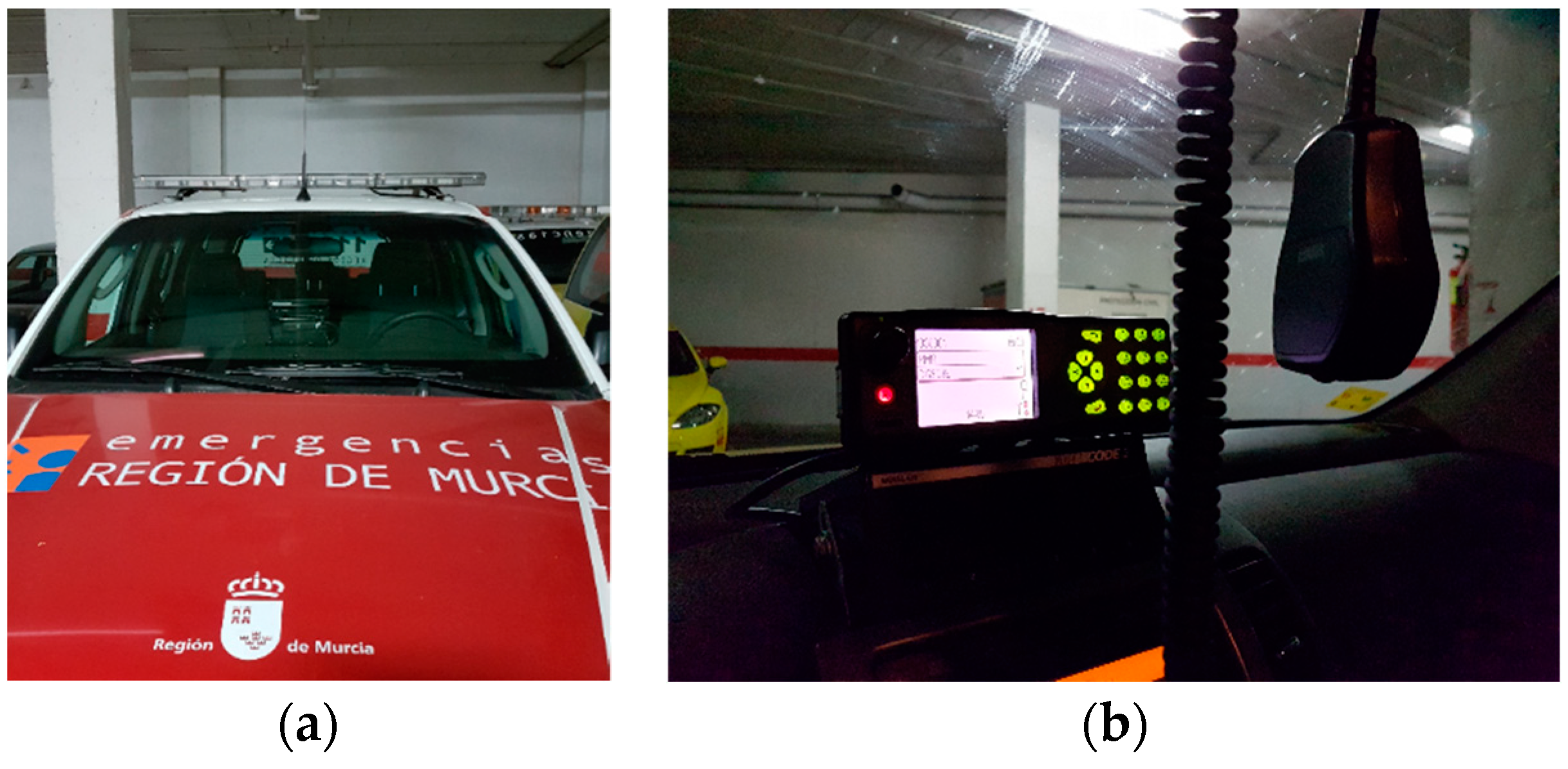
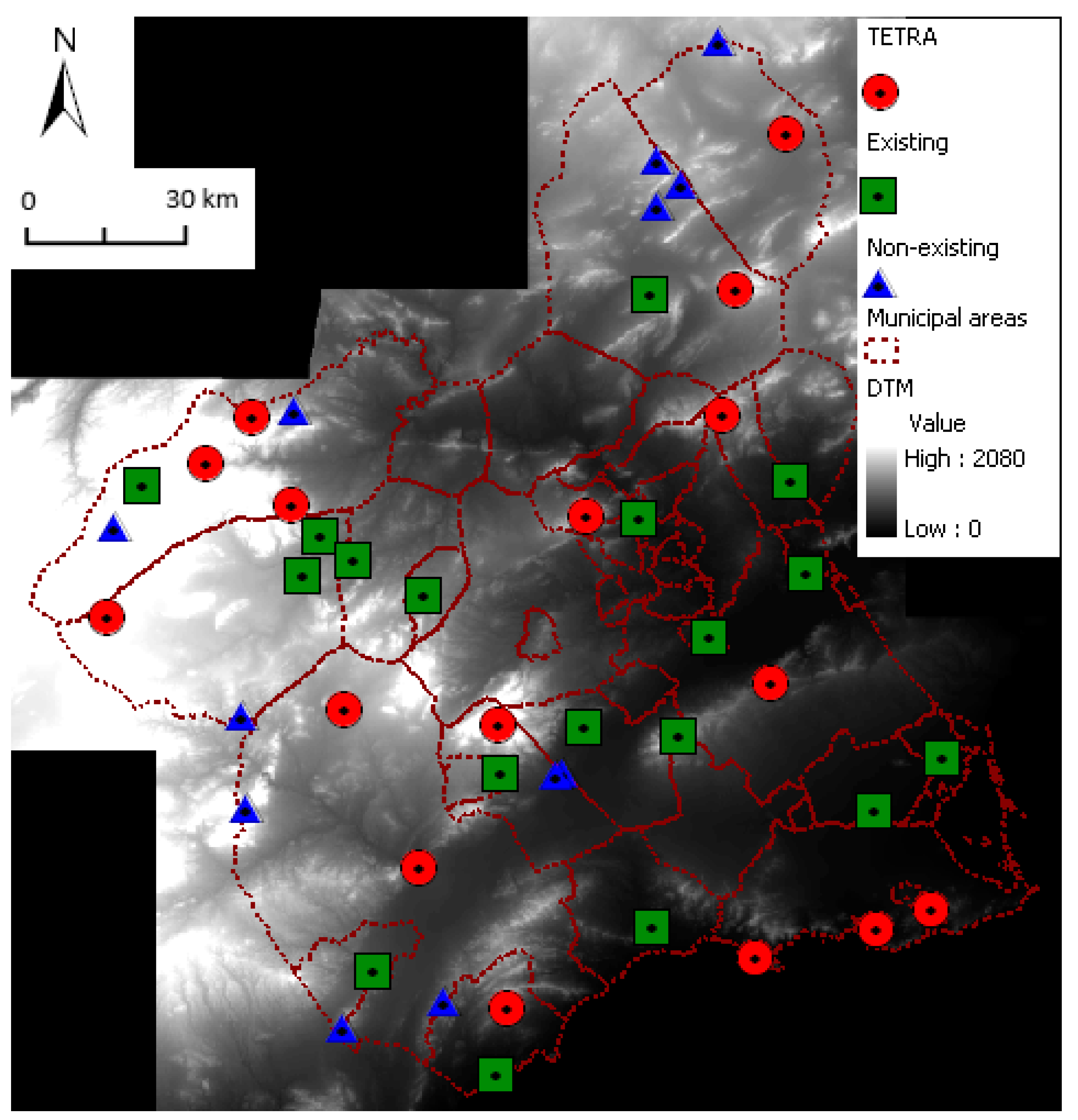
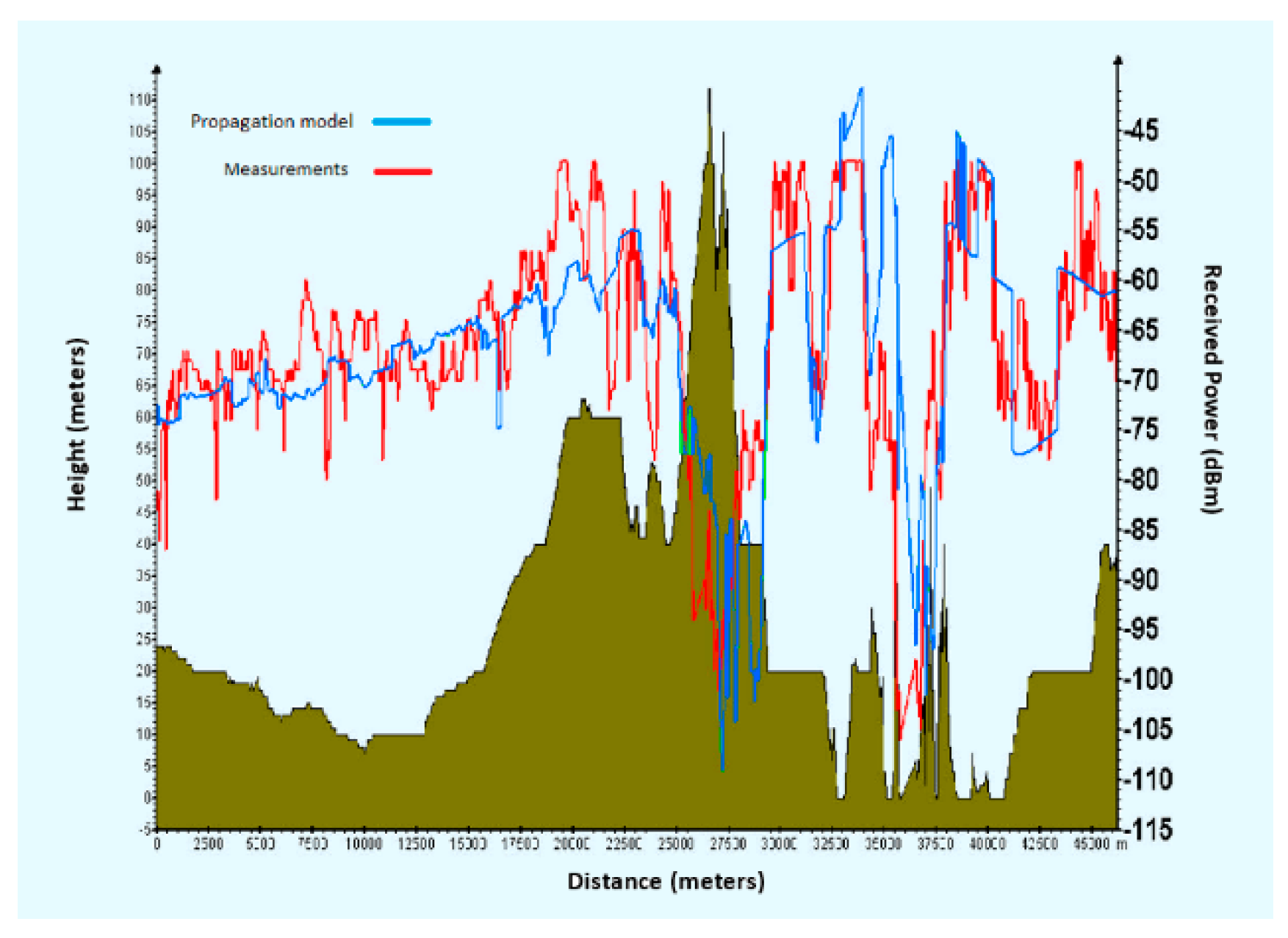
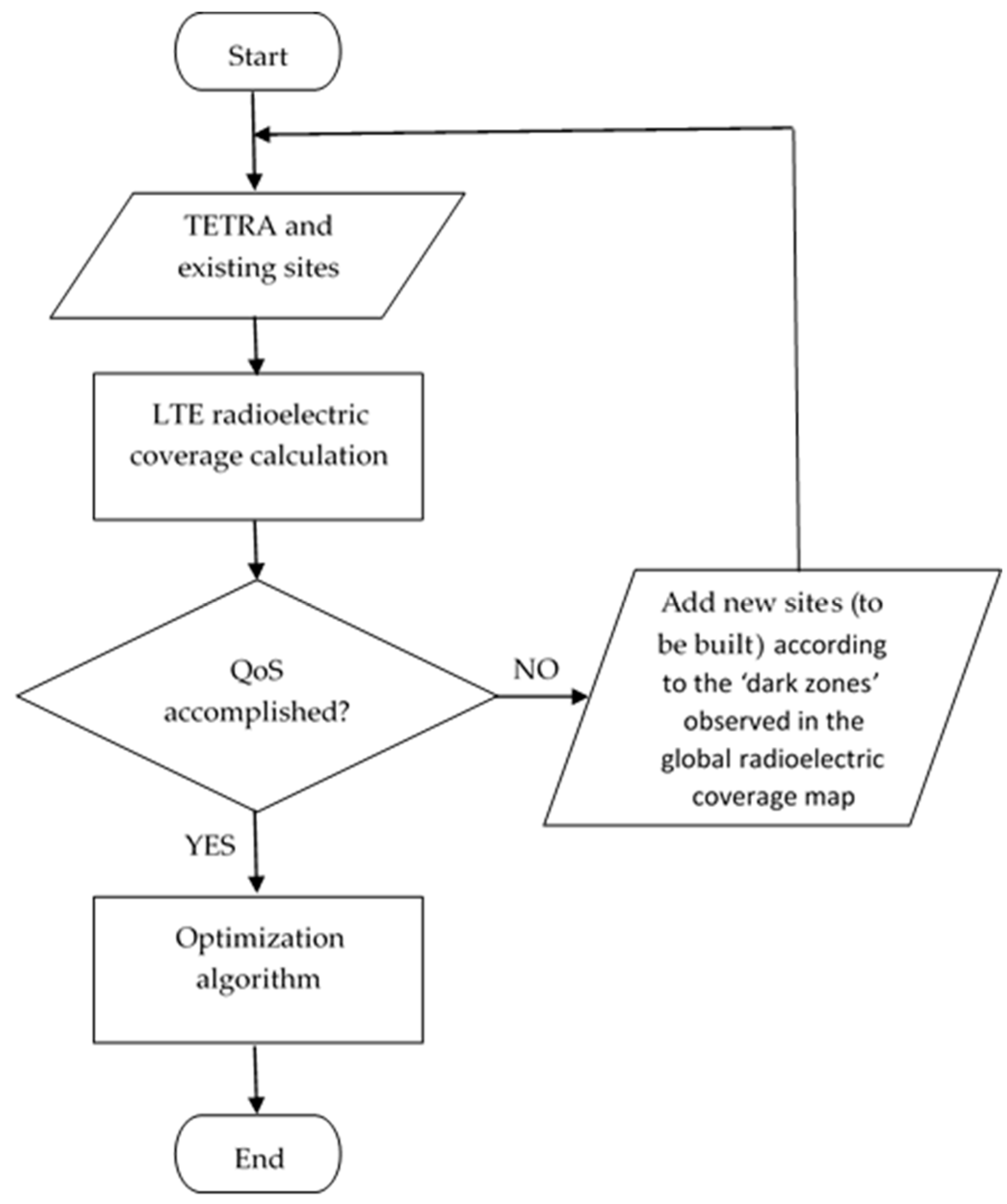
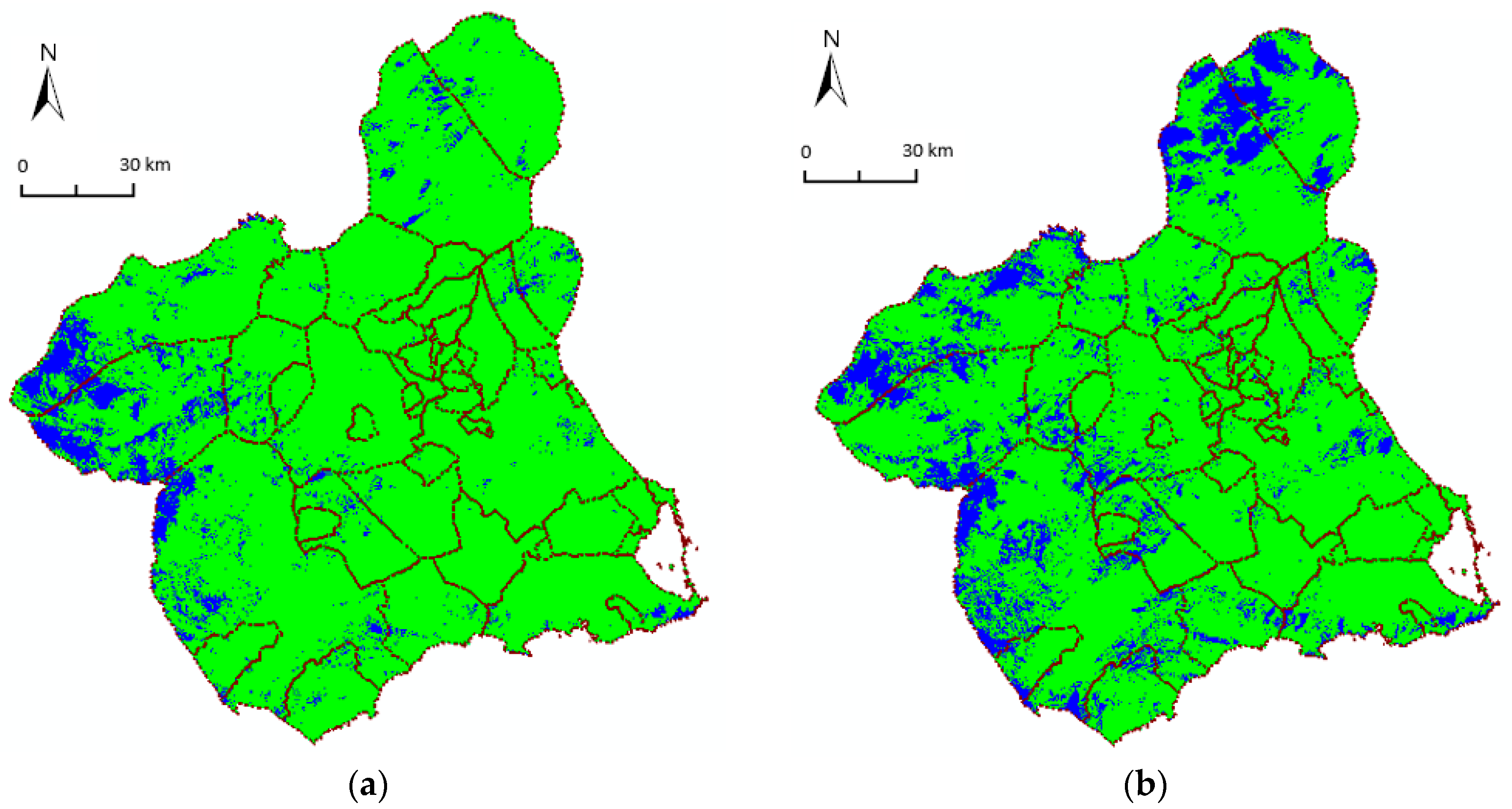
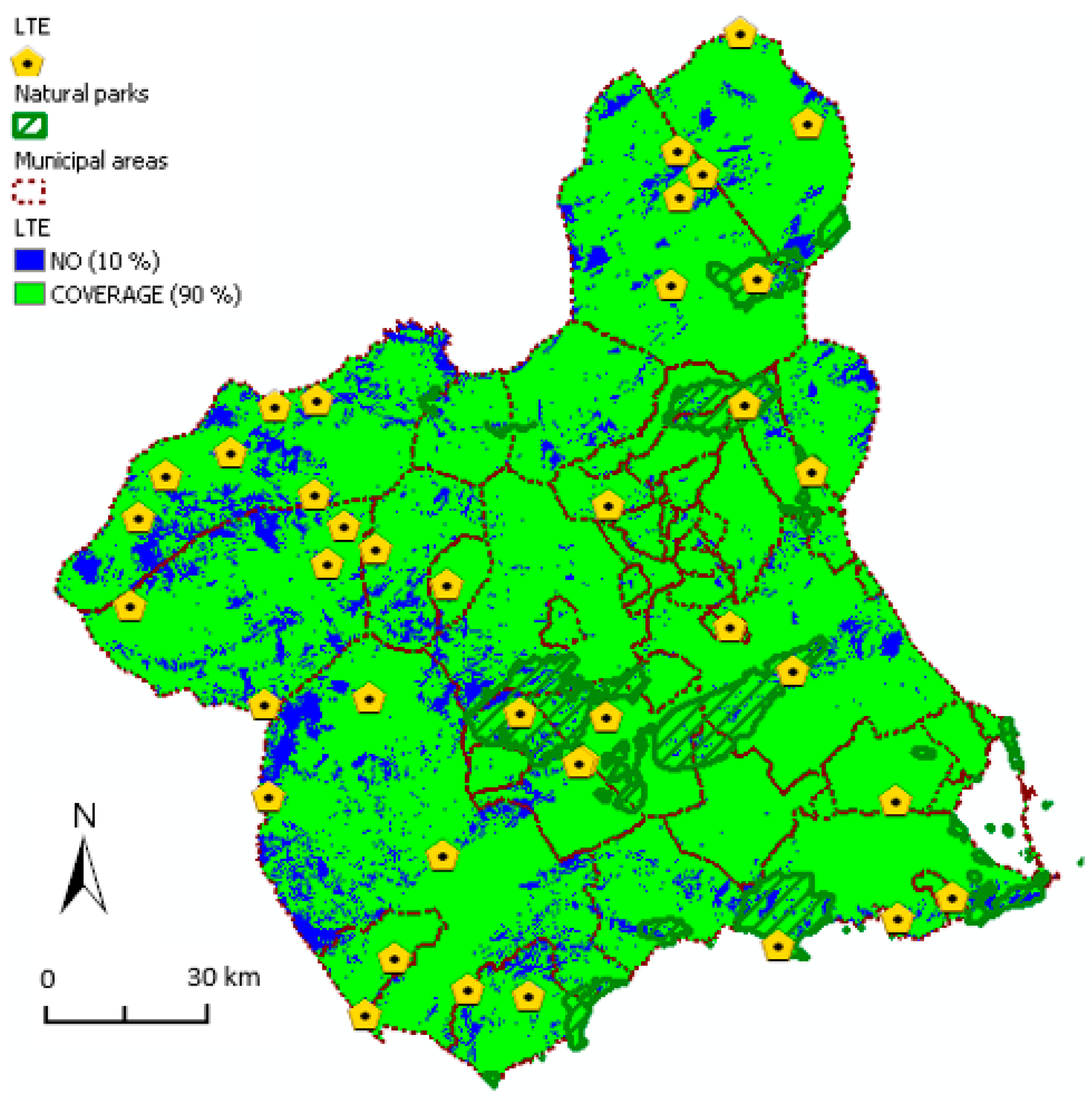
| Type of Environment | LClose environment (dB) (400 MHz, TETRA) | LClose environment (dB) (700 MHz, LTE) |
|---|---|---|
| No value | 0 | 0 |
| Rural (pine forest) | 10 | 14.5 |
| Suburban | 13.75 | 13.76 |
| Urban | 25.65 | 27.52 |
| Route Number | Mean Error (dB) | Standard Deviation (dB) |
|---|---|---|
| I | 1.04 | 8.34 |
| II | 8.96 | 9.20 |
| II | 3.63 | 8.45 |
| IV | −0.44 | 7.58 |
| V | 10.65 | 12.19 |
| TETRA | LTE | |||||
|---|---|---|---|---|---|---|
| Parameter | Units | DL | UL | DL | UL | |
| Power Tx | dBm | Ptx | 44 | 40 | 35 | 28 |
| Gain Tx | dBi | Gtx | 7 | 2 | 15 | 3.5 |
| Losses Tx | dB | Ltx | 2 | 0.5 | 2 | 0.5 |
| PIRE | dBm | Ptx + Gtx − Ltx | 50 | 41.5 | 48 | 31 |
| Fade Margin | dB | FM (90%) | 7.7 | 7.7 | 7.7 | 7.7 |
| Gain Rx | dBi | Grx | 2 | 7 | 3.5 | 15 |
| Losses Rx | dB | Lrx | 0.5 | 2 | 0.5 | 2 |
| Bandwidth | BW | 25 kHz | 5 MHz | |||
| Sensitivity | dBm | S | −103 | −106 | −95 | −100 |
| Lmax | dB | PIRE – FM + Grx − Lrx − S | 146.3 | 144.8 | 138.3 | 136.3 |
| Municipal Area | % TETRA Radioelectric Coverage (16 Sites) | % LTE Radioelectric Coverage (34 Sites) | % LTE Radioelectric Coverage (46 Sites) | % LTE Radioelectric Coverage (39 Sites) (Optimized) |
|---|---|---|---|---|
| Abanilla | 95 | 87 | 87 | 87 |
| Abarán | 97 | 97 | 97 | 96 |
| Águilas | 89 | 87 | 87 | 87 |
| Albudeite | 100 | 94 | 94 | 94 |
| Alcantarilla | 100 | 100 | 100 | 100 |
| Aledo | 100 | 96 | 98 | 95 |
| Alguazas | 100 | 96 | 96 | 96 |
| Alhama | 94 | 97 | 97 | 96 |
| Archena | 100 | 95 | 95 | 95 |
| Beniel | 100 | 100 | 100 | 96 |
| Blanca | 99 | 96 | 96 | 96 |
| Bullas | 96 | 96 | 96 | 96 |
| Calasparra | 96 | 91 | 91 | 91 |
| Campos del Río | 100 | 98 | 98 | 98 |
| Caravaca | 93 | 79 | 85 | 85 |
| Cartagena | 95 | 90 | 90 | 88 |
| Cehegín | 90 | 85 | 85 | 85 |
| Ceutí | 100 | 93 | 93 | 93 |
| Cieza | 98 | 92 | 92 | 92 |
| Fortuna | 99 | 93 | 93 | 93 |
| Fuente Álamo | 99 | 98 | 98 | 98 |
| Jumilla | 87 | 75 | 92 | 92 |
| Librilla | 94 | 99 | 99 | 99 |
| Lorca | 90 | 78 | 85 | 85 |
| Lorquí | 100 | 97 | 97 | 97 |
| Mazarrón | 94 | 89 | 89 | 88 |
| Molina de Segura | 100 | 98 | 98 | 98 |
| Moratalla | 86 | 71 | 85 | 85 |
| Mula | 96 | 91 | 91 | 91 |
| Murcia | 96 | 94 | 94 | 92 |
| Ojós | 98 | 95 | 95 | 94 |
| Pliego | 98 | 95 | 95 | 95 |
| Puerto Lumbreras | 91 | 85 | 94 | 94 |
| Ricote | 98 | 97 | 96 | 95 |
| San Javier | 100 | 99 | 100 | 98 |
| San Pedro del Pinatar | 100 | 100 | 100 | 90 |
| Torre-Pacheco | 98 | 100 | 100 | 99 |
| Las Torres de Cotillas | 100 | 97 | 97 | 97 |
| Totana | 92 | 84 | 88 | 86 |
| Ulea | 100 | 98 | 97 | 96 |
| La Unión | 99 | 92 | 92 | 92 |
| Villanueva | 100 | 98 | 98 | 98 |
| Yecla | 90 | 73 | 91 | 91 |
| Santomera | 99 | 94 | 94 | 91 |
| Los Alcázares | 100 | 100 | 100 | 99 |
| Region | 93 | 85 | 91 | 90 |
| Natural Park | % LTE Radioelectric Coverage (46 Sites) | % LTE Radioelectric Coverage (39 Sites) (Optimized) |
|---|---|---|
| Enclavado | 85% | 85% |
| Sierra Salinas | 97% | 96% |
| Sierra de El Carche | 88% | 88% |
| Sierra de La Pila | 90% | 88% |
| Ribera de Cañaverosa | 63% | 63% |
| Cañón de Almadenes | 53% | 44% |
| Ajauque y Rambla Salada | 99% | 99% |
| Carrascoy y El Valle | 92% | 92% |
| Barrancos de Gebas | 95% | 95% |
| Sierra Espuña | 81% | 78% |
| Salinas y Arenales de San Pedro | 100% | 90% |
| Saladares del Guadalentín | 100% | 100% |
| Cabezo Gordo | 97% | 90% |
| Islas del Mar Menor | 92% | 92% |
| La Muela y Cabo Tiñoso | 79% | 79% |
| Calblanque | 50% | 40% |
| Sierra de las Moreras | 73% | 73% |
| Islas mediterráneo | 97% | 93% |
| Calnegre y Cabo Cope | 88% | 88% |
| Cuatro Calas | 99% | 98% |
| Total | 86% | 84% |
© 2019 by the authors. Licensee MDPI, Basel, Switzerland. This article is an open access article distributed under the terms and conditions of the Creative Commons Attribution (CC BY) license (http://creativecommons.org/licenses/by/4.0/).
Share and Cite
del Rey Carrión, D.; Juan-Llácer, L.; Rodríguez, J.-V. Radio Planning Considerations in TETRA to LTE Migration for PPDR Systems: A Radioelectric Coverage Case Study. Appl. Sci. 2019, 9, 250. https://doi.org/10.3390/app9020250
del Rey Carrión D, Juan-Llácer L, Rodríguez J-V. Radio Planning Considerations in TETRA to LTE Migration for PPDR Systems: A Radioelectric Coverage Case Study. Applied Sciences. 2019; 9(2):250. https://doi.org/10.3390/app9020250
Chicago/Turabian Styledel Rey Carrión, Diego, Leandro Juan-Llácer, and José-Víctor Rodríguez. 2019. "Radio Planning Considerations in TETRA to LTE Migration for PPDR Systems: A Radioelectric Coverage Case Study" Applied Sciences 9, no. 2: 250. https://doi.org/10.3390/app9020250
APA Styledel Rey Carrión, D., Juan-Llácer, L., & Rodríguez, J.-V. (2019). Radio Planning Considerations in TETRA to LTE Migration for PPDR Systems: A Radioelectric Coverage Case Study. Applied Sciences, 9(2), 250. https://doi.org/10.3390/app9020250






